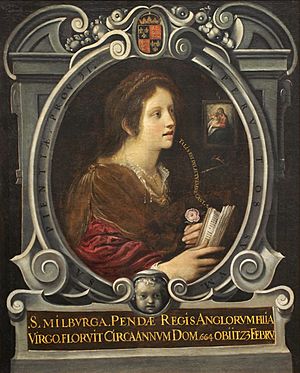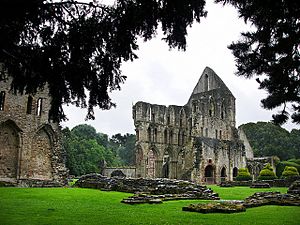Mildburh facts for kids
Quick facts for kids Saint Mildburh of Wenlock |
|
|---|---|

Santa Milburga, c. 1605, by Juan de Roelas
|
|
| Abbess | |
| Born | Unknown |
| Died | 23 February 727 |
| Venerated in | Roman Catholic Church Western Orthodoxy Eastern Orthodox Church Anglican Church |
| Canonized | Pre-Congregation |
| Feast | 23 February |
| Patronage | birds |
Saint Mildburh (also known as Milburga or Milburgh) was a special leader of a monastery. She was an abbess, which is like the head nun of a Benedictine monastery. She led the Wenlock Priory in England. She passed away on February 23, 727. Her special day, called a feast day, is celebrated every year on February 23.
Contents
Who Was Saint Mildburh?
Mildburh was the daughter of Merewalh, who was a king in a part of Mercia. Mercia was an old kingdom in England. Her mother was Domne Eafe. Mildburh had two younger sisters, Saint Mildrith and Saint Mildgytha.
People often compared the three sisters to important qualities. Mildburh was seen as representing faith. Mildgytha was linked to hope. Mildrith was connected to charity, which means kindness and giving.
A Royal Escape
A prince from a nearby area wanted to marry Mildburh. He was determined to have her as his wife. Mildburh did not want to marry him. She managed to escape by crossing a river.
The prince chased after her. But a surprising thing happened. The river suddenly swelled up and became too big to cross. This stopped the prince from following her.
Becoming an Abbess
After her escape, Mildburh joined a Benedictine monastery. This monastery was in a place called Wenlock, in Shropshire, England. Today, this town is known as Much Wenlock.
Her father and her uncle, Wulfhere of Mercia, helped start the nunnery. They gave money and land to support it. The first leader of the monastery was a French abbess named Liobinde. Mildburh later took over from Liobinde. She became the abbess with the help of Saint Theodore.
Mildburh had been educated in France. She was known for being very humble. People told stories about her special abilities. They said she could heal sick people. She was even said to have helped blind people see again.
She also helped spread Christianity in south Shropshire. She made sure people in the area received spiritual care.
Amazing Stories and Miracles
Many stories are told about Saint Mildburh's special powers. One story says she had a mysterious power over birds. She could ask them not to eat the crops in the fields. The birds would then listen to her and leave the crops alone.
She was also linked to other amazing events. One story says she caused a spring of water to appear. Another tells of barley growing very quickly.
There is a charming story about her veil. One morning, she overslept. When she woke, the sun was shining on her. Her veil slipped off her head. But instead of falling to the ground, it floated in the air. It stayed there on a sunbeam until she picked it up.
Mildburh passed away on February 23, 727. This is why her feast day is celebrated on that date.
Some historians believe that people connected Saint Mildburh to an older, non-Christian goddess. This might have happened in Shropshire. She was seen as a protector of grain, just like an ancient goddess might have been.
Rediscovery of Her Tomb
For a long time, people honored Mildburh's tomb. But then, invaders called the Danes destroyed her abbey.
After the Normans conquered England, new monks arrived. These monks were called Cluniac monks. They built a new monastery on the same spot. The ruins you see at Much Wenlock today are from this later monastery.
A Place for Pilgrims
In 1101, the Cluniac monks found what they believed were Mildburh's bones. They decided to make her tomb a special place for pilgrims. Pilgrims are people who travel to a holy site. They hoped to attract people with leprosy, a skin disease, to visit.
Local English people were not very happy about this. But it did attract many visitors from France and Wales. This also led to many new stories being written about Mildburh's life and miracles.
One important document was called Miracula Inventionis Beatae Mylburge Virginis. This means "Miracles of the Discovery of Blessed Mildburh the Virgin." A famous writer named Goscelin also wrote a book about her life. He included an older story that seemed to be Mildburh telling her own story.
Mildburh is also mentioned in old family trees of the Kentish Royal family. She is also listed in an 11th-century text. This text, called the Secgan, lists 89 saints and where they were buried.


